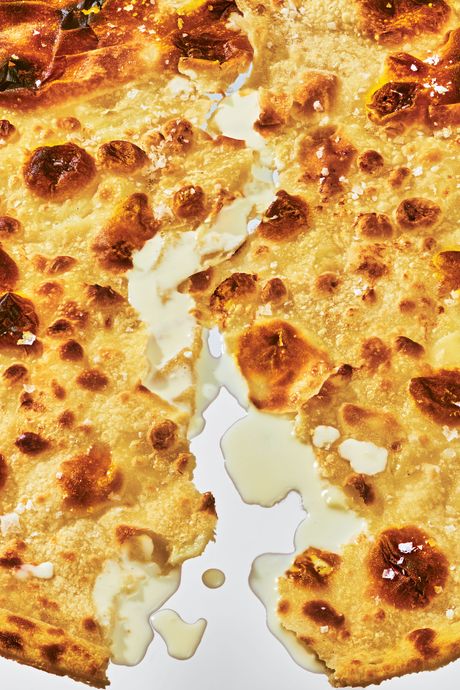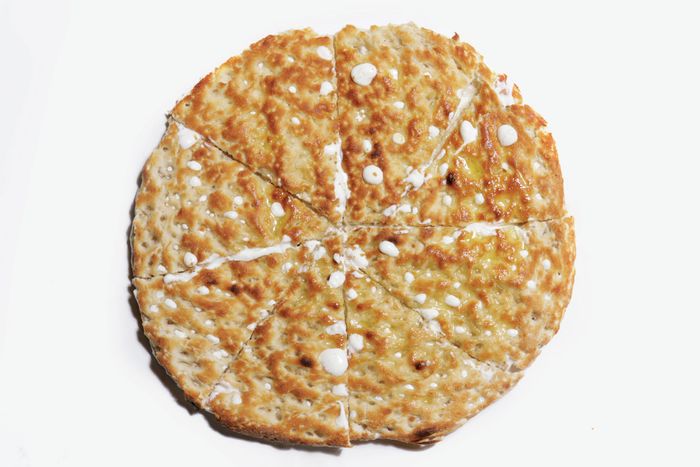Just when you thought you knew everything there is to know about the current craze for focaccia and all its pizzalike variants, along comes focaccia col formaggio di Recco (focaccia di Recco for short): a bubbly ooze of tart and fruity stracchino cheese barely contained by two supersize rounds of paper-thin dough.
To make focaccia di Recco, you take a simple ball of unleavened dough larded with olive oil, divide it in two, then roll and stretch the doughballs until you can read a newspaper through them (has anyone ever actually tested the translucency of a sheet of dough by reading a newspaper through it? ). Then you line a pan with one of the dough rounds, top it with scoops of cheese, cover and seal it with the second round of dough like an apple pie, drizzle with more olive oil, sprinkle with sea salt, and bake for about 10 minutes.
Mere mention of focaccia di Recco and its holy grail, the 134-year-old restaurant Manuelina in the Ligurian town of Recco, can cause worldly gastronomes to lose their minds. Italian-food guru and opera scholar Fred Plotkin has praised it as “indescribably wonderful” and “probably the most addictive food on the planet.” Saveur founder Colman Andrews has also described it as “…absolutely addictive — the kind of thing people make special trips to devour.” Not to be outdone, Vogue’s Jeffrey Steingarten wrote 2,500 words on the subject detailing his hunt for the recipe while extolling the dish as a kind of cross between a bag of potato chips and a grilled cheese sandwich.
What’s funny about focaccia di Recco is that, despite the name, it looks about as much like an ordinary focaccia as Christian Bale minus a fat suit and fifteen hours in the makeup artist’s chair looks like Dick Cheney. In fact, the thing a focaccia di Recco more closely resembles is a giant quesadilla or maybe an unusually thin slab of the Turkish breakfast pastry, su böreği.
Maybe the nomenclature is part of the reason why focaccia di Recco has never really taken off in New York, though there have been attempts, and also why one of the best versions of the dish goes under the alias of “stuffed garlic bread” at Don Angie in the West Village, where it’s sprinkled with sesame seeds and walks the line between a traditional focaccia di Recco and a scallion pancake. (Even in Italy, focaccia di Recco is not a household name outside of Liguria.)
The good news is that there’s a mini-flurry of activity on the local focaccia di Recco front. At Kesté Fulton in Fidi, Neapolitan-pizza master Roberto Caporuscio just added a first-rate version to his menu. It comes with Wisconsin crescenza cheese (stracchino by another name) and in a range of sizes including a supercolossal 25-inch model by special order.
Even more exciting is the news that restaurateur Shelly Fireman, whose enthusiasm for thin focaccia stuffed with stracchino cheese is almost Plotkinian, is back in the focaccia di Recco business. A dozen or so years ago, Fireman traveled to Manuelina and was so smitten by the signature dish that he hired the restaurant’s number one FDR guy on the spot and set up this focacciaiolo and his Maremma sheepdog in an apartment in Queens. The plan was for him to oversee focaccia di Recco production at Fireman’s restaurant Bond 45 in the theater district. Alas, the cook and his dog grew homesick for the rocky coasts and crystal waters of Liguria and headed back to Recco after only three weeks of city life. Fireman never lost his taste for focaccia col formaggio di Recco, though. And when he reopened his Redeye Grill on Seventh Avenue earlier this month, he put the dish on the menu of its new casual lounge area called the 888 Café & Bar.
This focaccia di Recco, baked in traditional copper pans, is as it should be: rich and salty, with an appealing range of textures, from crackly crisp to parathalike chewy, and sliced checkerboard-style like a Chicago thin-crust pizza. To what degree was it inspired by Manuelina? “It was not inspired by Manuelina,” says Fireman. “It was copied exactly.”
All this talk about focaccia stuffed with creamy Northern Italian cheeses has got us thinking about another double-crusted pizza variant, and we’d be remiss not to give it a shout-out. We’re talking about Ciro Verdi’s excellent focaccia robiola. A focaccia robiola isn’t a focaccia di Recco, but there are similarities. A focaccia robiola is constructed not from two separate sheets of dough but from a thin flatbread split in two like an English muffin. The inside gets schmeared with robiola cheese, then it’s relidded, drizzled with truffle oil, and cooked to a golden-brown fare-thee-well in the oven. The result is like an ethereal form of a toasted bagel with cream cheese (an original inspiration according to the Astoria, Queens-born Verdi), and it’s always baffled us that you can’t find focaccia robiola on every other street corner in the town where it was invented but only at a smattering of spots including Verdi’s Clinton Hill restaurant, Da Ciro, and his brother’s place Forno Pizzeria e Trattoria in Maspeth.
Interesting, too, that despite the similarities, Verdi had never seen or heard of the pride of Recco when he came up with his signature focaccia seemingly out of thin air while working as Pino Luongo’s pizza man at the late, great Le Madri in Chelsea. One fateful day in 1989, as Verdi tells it, Luongo, like the host of a cooking-competition show, presented Verdi with a block of robiola cheese as if it were a one-ingredient mystery-box challenge and said something to the effect of, “Here, Ciro, go and see what you can do with this.” Verdi rolled up his sleeves and got to work, and after not a little trial and error he nailed it. The dish was a smash hit at Le Madri and later at mad.61 at Barneys, where Verdi also ran the pizza program before he went on to open his own Murray Hill restaurant, Da Ciro, which relocated to Brooklyn in 2015.
Although it’s not the huge sensation we’ve always thought it should be, focaccia robiola has had a ripple effect throughout the greater pizzaverse, with Verdi-sanctioned versions available in Manhattan at Freds at Barneys, Amaranth, Gina La Fornarina, and Serafina, and in locales as far-flung as Maryland, Delaware, and Bogotá, Colombia. And if Fred Plotkin were ever to get his hands on a Da Ciro focaccia robiola, we’d venture to say he’d categorize it as “indescribably wonderful” or at least “addictive.”
*A version of this article appears in the August 5, 2019, issue of New York Magazine. Subscribe Now!






